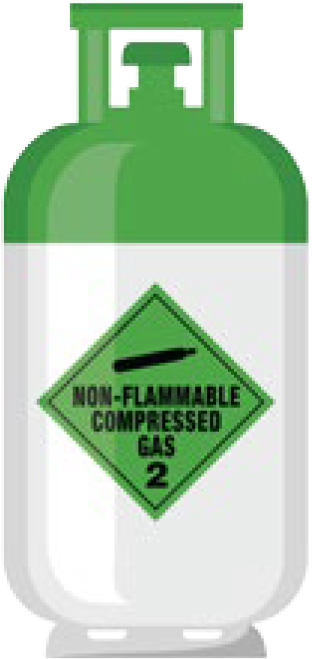



R744 is pure carbon dioxide. You do not need an ARCTick refrigerant handling licence or a refrigerant trading authorisation to handle, sell or store this refrigerant.
| PROPERTIES | R744 | R134a |
|---|---|---|
| Boiling Point | -78°C | -26°C |
| Critical Point | 31°C | 102°C |
| Saturation Pressure at 25°C | 6370 kPa gauge | 567 kPa gauge |
| Saturation Pressure at 80°C | Not Applicable | 2490 kPa gauge |
| Global Warming Potential | 1 | 1430 |
| Flammability Rating | A1 - Non Flammable | A1 - Non Flammable |
R744 requires systems and service equipment that are more durable than those used for R1234yf and R134a due to the high operating pressures.
R744 service equipment, which vents used refrigerant to atmosphere, has integrated fans to disperse the refrigerant. If R744 concentrations in the air increase to an unsafe level, built-in sensors shutdown the process and alert the technician. Vehicles using R744 have cabin air quality sensors that detect refrigerant leaks and let in fresh air if R744 concentrations exceed 800 parts per million (average atmospheric levels are below 400ppm).
Handling equipment for R744 is not yet commonly available in Australia. Contact your refrigerant wholesaler or the vehicle manufacturer if you have questions about equipment for R744.
No. R744 operates on pressures up to ten times higher than R134a. Although it has been used for some time in stationary equipment, developing R744 systems for automotive applications has been a significant engineering challenge, with unique components and system layouts required for this refrigerant.
Working with R744 will require new service equipment meeting the relevant SAE standards, as well as technical training about the major differences. Contact your local TAFE or relevant registered training organisation to see if they incorporate R744 into their automotive air conditioning training.
No. R134a systems were not designed to operate using a high pressure refrigerant.
R744 is available from most refrigerant wholesalers and automotive air conditioning component suppliers.
No. R744 is not controlled under Australia’s Ozone Protection and Synthetic Greenhouse Gas legislation. However, a licence is required if it is part of a blend containing a controlled HFC refrigerant. In addition, R134a will still be available, and in older systems, for years to come. It is a legal requirement that automotive workshops who provide air conditioning services (including recovery) continue to hold a refrigerant handling licence and refrigerant trading authorisation if R134a is being used.
For additional licensing requirements, check with your relevant state-based licensing authorities.
R744 systems operate at extremely high and dynamic pressures. Even when the system is turned off, the static pressure of R744 is still very high.
R744 can displace oxygen if released in excessive amounts (it is heavier than air and can congregate), and therefore precautions must be taken to prevent its release and breathing in of high levels of CO2. Do not handle this refrigerant in confined spaces. All precautions must be taken to prevent its release. Symptoms from overexposure to CO2 range from drowsiness to asphyxiation, and in extreme cases, death. But the right training, equipment and attitude will allow safe use of R744.
R744 systems must also be charged and degassed in a specific manner to avoid the formation of dry ice inside the refrigerant pipework. Frost burns can occur if contact is made with liquid or solid CO2. Appropriate Personal Protective Equipment (PPE) must be used. Refer to the relevant material safety data sheets, and ensure system specific safety procedures are followed.
For example, R744 systems can operate at up to 170 bar (2466 psi) and trapped liquid CO2 in hoses can cause pressure explosions if exposure to higher temperatures causes a phase change.
If dry ice is allowed to form, it can cause severe skin burns and block parts of the system for long periods of time until it has evaporated.